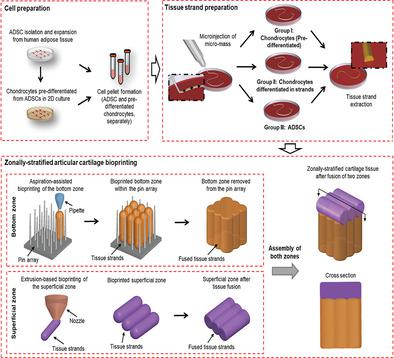当前位置:
X-MOL 学术
›
Adv. Healthcare Mater.
›
论文详情
Our official English website, www.x-mol.net, welcomes your
feedback! (Note: you will need to create a separate account there.)
Hybrid Bioprinting of Zonally Stratified Human Articular Cartilage Using Scaffold‐Free Tissue Strands as Building Blocks
Advanced Healthcare Materials ( IF 10.0 ) Pub Date : 2020-10-19 , DOI: 10.1002/adhm.202001657 Yang Wu 1, 2 , Bugra Ayan 1, 2 , Kazim K Moncal 1, 2 , Youngnam Kang 1, 2 , Aman Dhawan 3 , Srinivas V Koduru 4, 5 , Dino J Ravnic 4 , Fadia Kamal 6, 7 , Ibrahim T Ozbolat 1, 2, 8, 9
Advanced Healthcare Materials ( IF 10.0 ) Pub Date : 2020-10-19 , DOI: 10.1002/adhm.202001657 Yang Wu 1, 2 , Bugra Ayan 1, 2 , Kazim K Moncal 1, 2 , Youngnam Kang 1, 2 , Aman Dhawan 3 , Srinivas V Koduru 4, 5 , Dino J Ravnic 4 , Fadia Kamal 6, 7 , Ibrahim T Ozbolat 1, 2, 8, 9
Affiliation

|
The heterogeneous and anisotropic articular cartilage is generally studied as a layered structure of “zones” with unique composition and architecture, which is difficult to recapitulate using current approaches. A novel hybrid bioprinting strategy is presented here to generate zonally stratified cartilage. Scaffold‐free tissue strands (TSs) are made of human adipose‐derived stem cells (ADSCs) or predifferentiated ADSCs. Cartilage TSs with predifferentiated ADSCs exhibit improved mechanical properties and upregulated expression of cartilage‐specific markers at both transcription and protein levels as compared to TSs with ADSCs being differentiated in the form of strands and TSs of nontransfected ADSCs. Using the novel hybrid approach integrating new aspiration‐assisted and extrusion‐based bioprinting techniques, the bioprinting of zonally stratified cartilage with vertically aligned TSs at the bottom zone and horizontally aligned TSs at the superficial zone is demonstrated, in which collagen fibers are aligned with designated orientation in each zone imitating the anatomical regions and matrix orientation of native articular cartilage. In addition, mechanical testing study reveals a compression modulus of ≈1.1 MPa, which is similar to that of human articular cartilage. The prominent findings highlight the potential of this novel bioprinting approach for building biologically, mechanically, and histologically relevant cartilage for tissue engineering purposes.
中文翻译:

使用无支架组织链作为构建块的区域分层人类关节软骨的混合生物打印
异质和各向异性的关节软骨通常被研究为具有独特组成和结构的“区域”的分层结构,使用当前的方法很难概括这一点。这里提出了一种新颖的混合生物打印策略来生成区域分层软骨。无支架组织链 (TS) 由人类脂肪干细胞 (ADSC) 或预分化 ADSC 组成。与以链形式分化的 ADSC 的 TS 和未转染的 ADSC 的 TS 相比,具有预分化 ADSC 的软骨 TS 在转录和蛋白质水平上表现出改善的机械性能和软骨特异性标记物的表达上调。使用集成新的抽吸辅助和基于挤出的生物打印技术的新型混合方法,演示了带状分层软骨的生物打印,其底部区域垂直对齐的 TS 和浅层区域水平对齐的 TS,其中胶原纤维与指定的区域对齐每个区域的方向模仿天然关节软骨的解剖区域和基质方向。此外,机械测试研究表明其压缩模量约为1.1 MPa,与人类关节软骨的压缩模量相似。这些突出的发现凸显了这种新型生物打印方法在构建生物学、机械学和组织学相关软骨以用于组织工程目的方面的潜力。
更新日期:2020-11-18
中文翻译:

使用无支架组织链作为构建块的区域分层人类关节软骨的混合生物打印
异质和各向异性的关节软骨通常被研究为具有独特组成和结构的“区域”的分层结构,使用当前的方法很难概括这一点。这里提出了一种新颖的混合生物打印策略来生成区域分层软骨。无支架组织链 (TS) 由人类脂肪干细胞 (ADSC) 或预分化 ADSC 组成。与以链形式分化的 ADSC 的 TS 和未转染的 ADSC 的 TS 相比,具有预分化 ADSC 的软骨 TS 在转录和蛋白质水平上表现出改善的机械性能和软骨特异性标记物的表达上调。使用集成新的抽吸辅助和基于挤出的生物打印技术的新型混合方法,演示了带状分层软骨的生物打印,其底部区域垂直对齐的 TS 和浅层区域水平对齐的 TS,其中胶原纤维与指定的区域对齐每个区域的方向模仿天然关节软骨的解剖区域和基质方向。此外,机械测试研究表明其压缩模量约为1.1 MPa,与人类关节软骨的压缩模量相似。这些突出的发现凸显了这种新型生物打印方法在构建生物学、机械学和组织学相关软骨以用于组织工程目的方面的潜力。










































 京公网安备 11010802027423号
京公网安备 11010802027423号